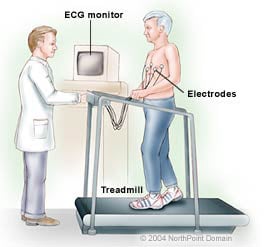Treadmill stress test
 The treadmill stress test is a basic cardiology test that helps the physician determine how the heart responds to the effort. As the effort increases, the body needs more oxygen. This results in the heart pumping more blood. The test will show if blood supply to the heart arteries (coronary arteries) is reduced. It will also help the physician determine the type and intensity of exercise that is appropriate for each patient.
The treadmill stress test is a basic cardiology test that helps the physician determine how the heart responds to the effort. As the effort increases, the body needs more oxygen. This results in the heart pumping more blood. The test will show if blood supply to the heart arteries (coronary arteries) is reduced. It will also help the physician determine the type and intensity of exercise that is appropriate for each patient. - To diagnose coronary heart disease
- To assess symptoms that are likely to be related to heart problems (chest pain, dyspnoea, dizziness)
- To evaluate the effectiveness of previous cardiac interventions. – To evaluate the effectiveness of medication the patient receives for his heart.
- To predict the likelihood of a heart attack.
- To assess the level of exercise that is safe for the subject.
- And of course in the context of a more general assessment of the health of the subject, especially when starting a new exercise program.



